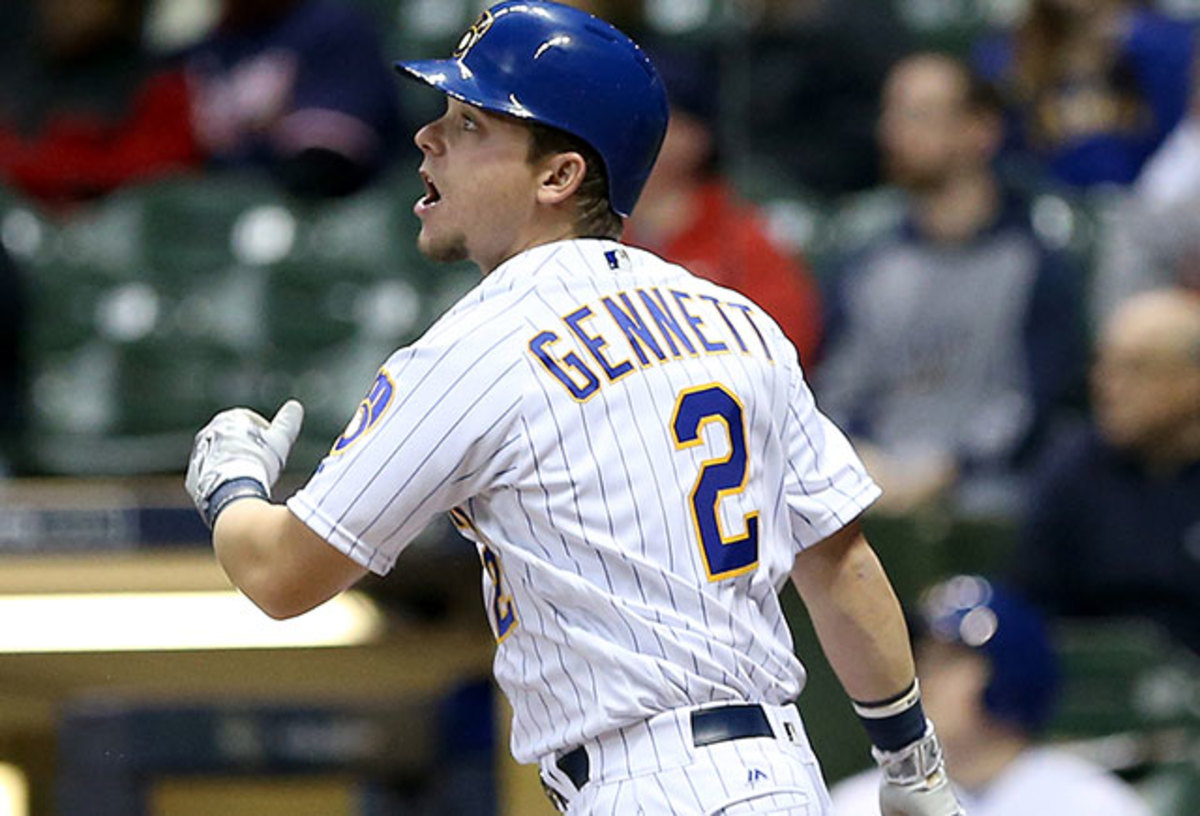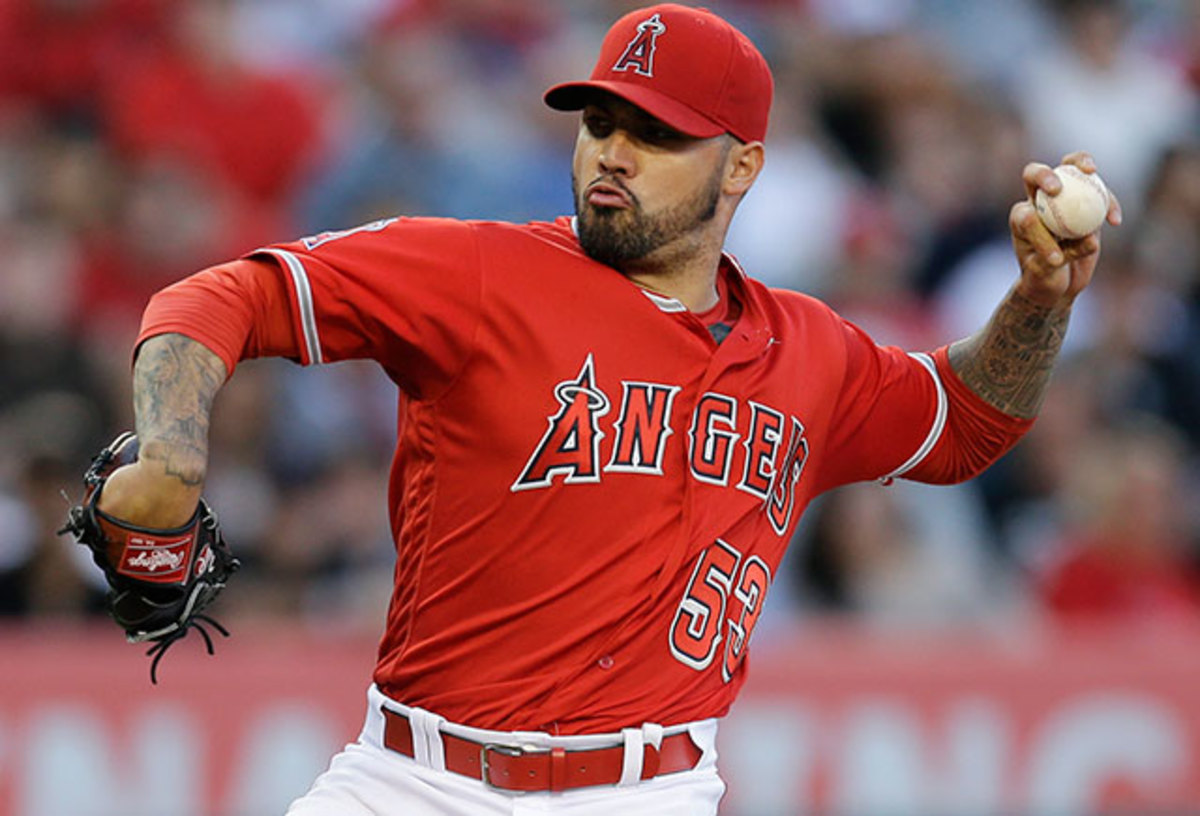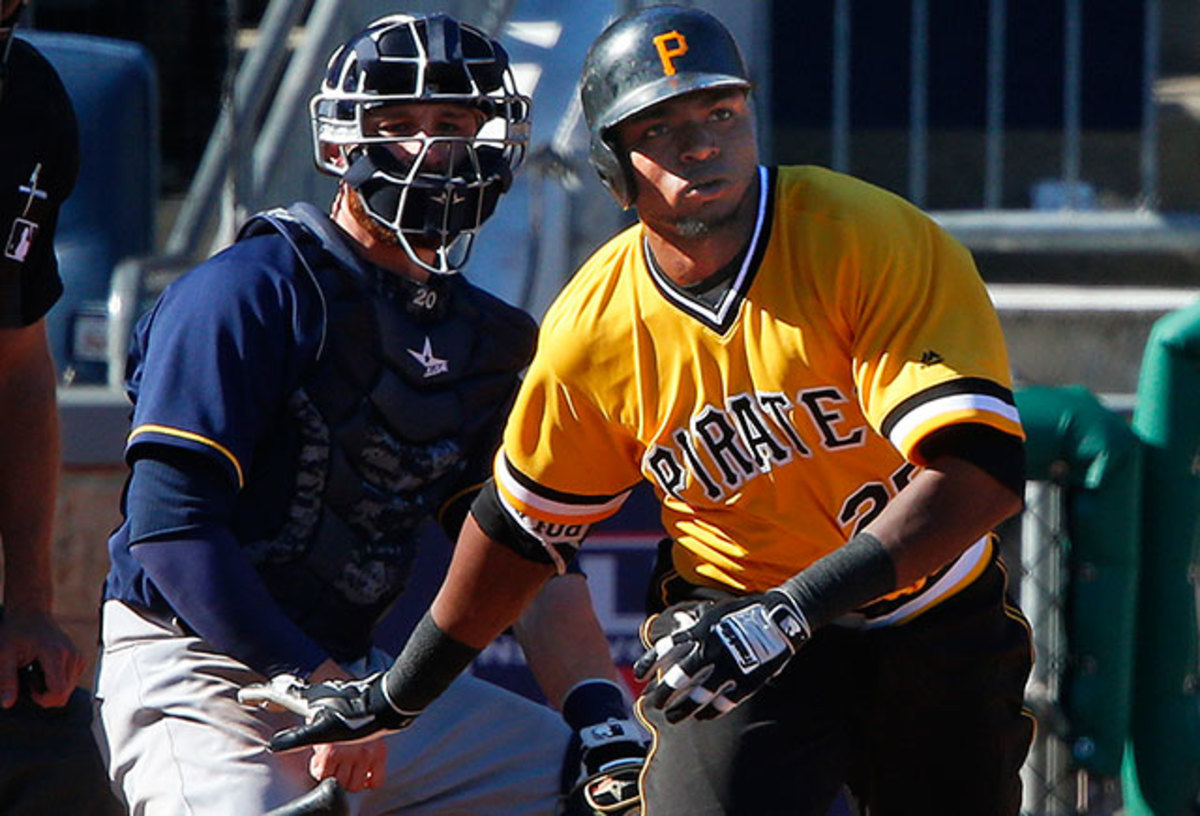The 30: Can these four players keep up their 2016 breakouts?

It’s early. That’s baseball’s mantra in late April, when stars can look awful, scrubs can look great and some key players coming off spring injuries haven’t even taken the field yet. It’s easy (and usually correct) to invoke the small sample size song and call it a day. Of course, we shouldn’t ignore individual performances entirely, and when talented, young players put up impressive numbers, it bears monitoring—even if it’s just three weeks’ worth of success.
This week’s four featured teams all boast 20-something players performing at career-best levels. The rebuilding Brewers are getting big returns from normally light-hitting Scooter Gennett. Hector Santiago is helping the Angels’ cause, even though the Halos can’t hit. Gregory Polanco might be starting to fulfill his star potential for the Pirates. Meanwhile, in Kansas City, Mike Moustakas vies for a career high (and maybe a franchise high) in homers.
Breakouts might be coming. It’s Week 3 of The 30.
Best Display of Derring-Do: Jacoby Ellsbury
Ty Cobb, Honus Wagner, Jackie Robinson, Rod Carew: The list of players who most frequently stole home reads like a roll call of old-timers from long-ago eras. Today, even thinking about swiping home doesn’t happen often. Restrict the conversation to straight steals of home (as opposed to on double steals), and it’s perceived as a shocking, risky, extremely rare play—like witnessing an eclipse.
Jacoby Ellsbury was willing to take that risk. In the bottom of the fifth on Friday night, with the Yankees trailing 3–2 and two outs and a full count on Brett Gardner, Ellsbury took off from third. His head-first slide just evaded the tag of Rays catcher Curt Casali, catching the corner of the plate and tying the game. It was a thriller.
For Ellsbury, that marked his second steal of home in his career, following his scintillating swipe in April 2009. It was also the first time a Yankee has stolen home since Derek Jeter pulled it off way back in 2001. We probably won’t ever go back to the days of Cobb- and Jackie-level daring. But even an occasional glimpse of the most exciting play in baseball is a joy to behold.
• MORE MLB: Blake Snell shows his potential for Rays in MLB debut

Dandy at the Deuce
A year after losing his job, Scooter Gennett is pounding baseballs all over the yard.
30. Atlanta Braves (4–14 record, minus-31 run differential, last week: 30)
29. Minnesota Twins (5–14, minus-21, LW: 29)
28. Miami Marlins (6–11, minus-15, LW: 27)
27. San Diego Padres (7–12, minus-29, LW: 28)
26. Milwaukee Brewers (8–11, minus-37, LW: 25)
25. Cincinnati Reds (9–10, minus-40, LW: 24)
24. Philadelphia Phillies (9–10, minus-26, LW: 26)
The Brewers occupy last place in the NL Central, with the second-worst run differential in all of baseball. Most of the building blocks for the next contending Milwaukee team sit in the minors, with the fruits of recent drafts, international signings and shrewd trades starting to round into form. That leaves few young players with breakout potential worth watching on the major league roster . . . except, apparently, for Scooter Gennett.
MLB expansion? These cities in U.S. and abroad make sense
Gennett broke into the big leagues in impressive fashion in 2013, hitting .324 in 69 games. Even in that impressive debut, though, you could see the holes in his game. A free swinger, he ranked near the bottom of the league with a 4.3% walk rate. And while he showed some propensity to hit doubles, a 5'10", 185-pounder named “Scooter” isn’t a great bet to suddenly hit for a ton of power. Fewer balls fell into play safely over the next two seasons, such that in 2015, Gennett batted just .264/.294/.381, looking like the kind of replacement-level player you’d want to cut loose as soon as a half-decent alternative emerged.
Not anymore. A few days shy of his 26th birthday, Gennett suddenly looks like a totally different hitter. Through 18 games, Gennett’s hitting a career-best .258/.361/.516 and is walking three times more often than his career rate, posting a lofty 13.9% mark this year. Most exciting of all, he’s crushing the ball: His hard-hit average has surged to career-best territory, and his soft-hit average ranks among the lowest in the league. Numbers aside, watch Gennett this season and you’re seeing a player cranking balls with authority: Before this season, how many times can you remember him hitting a ball as hard and deep as he did on this opposite-field homer(!) off Philadelphia's Jared Eickhoff on Sunday?
Given how aggressive Brewers GM David Stearns has been about shopping veterans for future help, Gennett’s drastic improvement could end up benefiting some other team if it continues (ditto for Ryan Braun, who looks like vintage Braun so far this year). Still, given that Gennett was so punchless last season that he lost his job and got sent to Triple A for a while, this would still count as a big break for the Crew’s goal of contending in 2018 and beyond.

Pitching In
With their offense struggling badly, Hector Santiago’s arm has helped keep the Angels (barely) afloat.
23. Los Angeles Angels (8–11, minus-18, LW: 22)
22. Tampa Bay Rays (8–10, minus-2, LW: 19)
21. New York Yankees (7–10, minus-12, LW: 16)
20. Houston Astros (6–13, minus-20, LW: 15)
19. Colorado Rockies (9–9, minus-10, LW: 20)
18. Oakland A’s (10–9, minus-4, LW: 21)
17. Detroit Tigers (8–9, minus-3, LW: 11)
16. Arizona Diamondbacks (10–10, minus-1, LW: 23)
15. Seattle Mariners (9–9, plus-9, LW: 18)
The Angels rank dead last in the majors in runs scored, as owner Arte Moreno’s refusal to stretch payroll and threaten the luxury-tax threshold this off-season has resulted in an offense that looks listless outside of Mike Trout. Los Angeles' second-biggest offensive threat, Albert Pujols, is hitting .153, and that’s after breaking an 0-for-26 streak on Sunday. The Halos have looked awful through the first three weeks of the season, and they’d look even worse if not for Hector Santiago.
A 28-year-old lefthander, Santiago has tasted major league success before. In the first half of last season, he posted a 2.33 ERA, struck out nearly three batters for every one walk and made his first All-Star team. He’s pitching even better through his first four starts of 2016. In his fourth season since shifting to the rotation, Santiago has posted the highest strikeout rate (25.7%), lowest walk rate (7.6%) and highest ground-ball rate (48.6%) of his career.
So here’s the question: Is this real?
Jake Arrieta, Bob Gibson and the most dominant pitching runs ever
At first glance, Santiago’s results on balls in play might suggest otherwise. Only seven other qualified starters have yielded a lower batting average on balls in play than Santiago’s .197. Then again, when you allow a tiny number of line drives, fewer balls are going to fall in for hits, and only two starters have undercut Santiago’s 8.6% line-drive rate. Santiago has also seen his swing-and-miss rate surge to 11.5% this year, well above last year’s career-best of 8.5. Throw in career-best results against his four-seam fastball—opponents are slugging just .306 on that pitch this year, as Santiago is throwing the pitch higher in the zone than he has in the past (per TruMedia)—and there are positive signs here.
Of course, all of this granular analysis ignores the elephant in the room: Four starts constitute a tiny sample size. We still have a long way to go before any of his pitching stats hit the milestones that mark them as becoming predictive for the rest of the season. But given how weak the offense has been (ranking last in the majors in batting average and on-base percentage and next-to-last in slugging percentage) and figures to remain this year, the Angels have to hope that Santiago’s season will be a surprising silver lining.

Coffee Break
Gregory Polanco’s huge start cements the Pirates' outfield as the best in baseball.
14. Boston Red Sox (9–9, plus-0, LW: 8)
13. Texas Rangers (10–9, plus-1, LW: 12)
12. San Francisco Giants (9–11, plus-10, LW: 6)
11. Toronto Blue Jays (10–10, plus-9, LW: 14)
10. Cleveland Indians (9–7, plus-9, LW: 17)
9. Pittsburgh Pirates (10–9, plus-1, LW: 7)
8. New York Mets (10–7, plus-22, LW: 13)
7. Baltimore Orioles (11–6, plus-14, LW: 9)
The expectations were always huge. From being signed as an amateur out of the Dominican Republic at age 17 in 2009 to being named Baseball America’s No. 10 prospect in the game in '14 to showing glimpses of dazzling athleticism when he made his major league debut later that year, the question has always been when, not if, Gregory Polanco would ever become a star.
Bucs fans and management always played up the positives over the negatives—the elite base running and impressively agile defense and the big jump in his 2015 second-half performance that overshadowed a listless first half. Three weeks ago, the Pirates gave Polanco a contract that locks him up potentially through '23, figuring the best was yet to come.
The best might now be here. So far this season, Polanco has been an offensive force, batting a cool .318/.432/.500. Granted, we haven’t yet seen his immense power potential bear fruit yet, with El Coffee sitting on just one home run. But the 24-year-old rightfielder has shown flashes of a skill that could portend big things: So far in 2016, he’s absolutely owned the strike zone.
In better spirits and shape, Yasiel Puig aims for fresh start
In 83 plate appearances so far this season, Polanco has drawn 14 walks and struck out just 10 times. That gives him the seventh-best walk-to-strikeout rate in all of baseball. Examine the rest of his plate discipline profile, and Polanco’s numbers look like those of a poised, 10-year veteran. He’s swinging at fewer pitches out of the strike zone than ever before and swinging and missing less often than ever before. That’s how you end up ranking among the league leaders in on-base percentage, a skill that fits right in on a Pirates team that leads the majors in that crucial stat, by a wide margin.
Consider the even more exciting angle here, though. Polanco is a 6'5", 230-pound physical specimen who’s long been expected to mature into a major source of power. When a hitter learns to distinguish balls from strikes as well as he has, what often follows are a whole lot of hitter’s counts. Put Polanco into a bunch of 3–1 and 2–0 situations, and he’ll not only keep drawing walks, but he’ll also likely start blasting more pitches out of the park.
If that happens, the combination of Polanco, Starling Marte and Andrew McCutchen wouldn’t merely rank as the best all-around outfield in the game today. It would have a chance to go down as one of the best outfields the game has seen in years.
The Moose Is Loose
Mike Moustakas’s spiking power threatens to wave bye-bye to the Royals’ single-season home-run record.
6. Chicago White Sox (13–6, plus-14, LW: 10)
5. St. Louis Cardinals (10–8, plus-40, LW: 5)
4. Los Angeles Dodgers (12–7, plus-23, LW: 4)
3. Kansas City Royals (12–6, plus-15, LW: 3)
2. Washington Nationals (14–4, plus-34, LW: 2)
1. Chicago Cubs (14–5, plus-68, LW: 1)
Pundits have tacked all kinds of explanations onto the Royals’ back-to-back AL pennants. We’re told their success validates the power of speed, or defense, or contact hitting, or a deep bullpen, or spitting on a widely misunderstood book that came out 13 years ago. But the biggest reason the Royals have become a dominant force is a simple one: They were exceedingly patient with their young players.
No young player tested that patience more than Mike Moustakas. The No. 2 pick in the 2007 draft and a top-rated prospect for four years in a row before his call to the Show in '11, he struggled mightily for the first four years of his career, ranking as the 13th-worst full-time hitter in the American League in that stretch (out of 129). Moustakas’s Achilles heel was his prolific out-making, as the lefty-swinging third baseman batted .236 with a .290 on-base percentage over those four seasons.
Cubs' Arrieta throws second no-hitter, furthers claim as game's best starter
Moustakas still hasn’t learned how to take free passes the way, say, Polanco has this season. But what he has done is learn how to channel his excellent hand-eye coordination into strong results. He’s swinging at fewer pitches out of the zone, swinging and missing less often and falling behind on the first pitch less often than he ever has before. Meanwhile, his strikeout rate has dipped to a career-low 10.7%.
That improved batting eye has dovetailed with Moustakas’s improving power at the big-league level, turning him into a dangerous hitter. He followed his five postseason homers in 2014 with a career-high 22 in the regular season last year. This season, his power’s been off the charts, with only Josh Donaldson, Manny Machado and the white-hot Colby Rasmus topping him by isolated power (slugging average minus batting average).
As you might expect, there are a few indicators here which suggest that Moustakas’s early-season homer binge will cool off before long. Most notably, he’s hit a home run on about one-quarter of his fly balls to notch his six home runs, a ludicrously high rate that only Nelson Cruz, Chris Davis and Mike Trout could maintain last year among AL players.
Still, the Royals’ single-season home run record of 36, set by Steve Balboni in 1985, has stood for more than three decades. Discussing any player having a shot at that mark is a rarity for the Royals, whose ballpark and long history of favoring multi-tool players over brute-force sluggers have long worked against that possibility. Avoid the wrath of the punchout crew, and Moose just might have a shot at the record.
